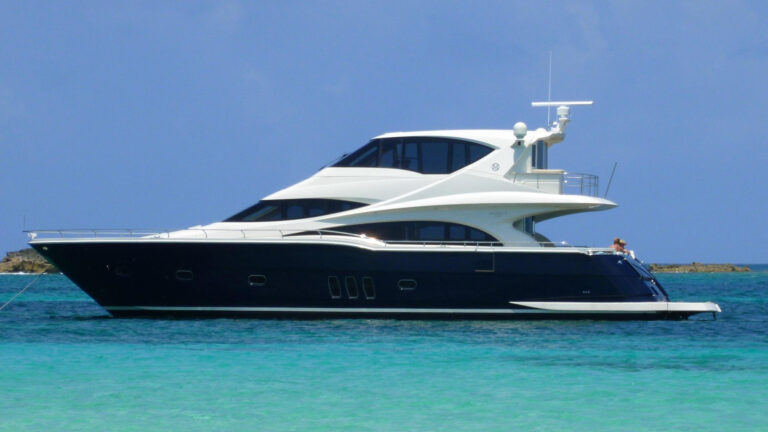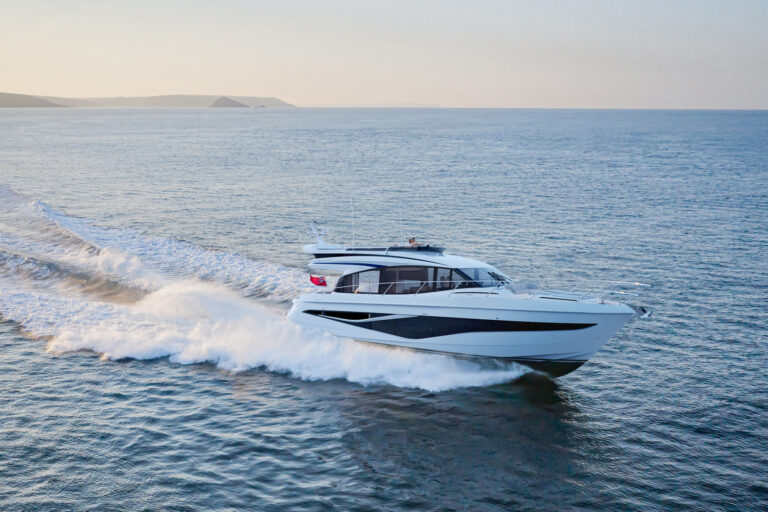In Palm Beach, Florida, a few months ago, I bumped into a commercial fisherman and his wife aboard the Fitzroy 80 Spirit of Fitzroy. They hailed from Vancouver, British Columbia, and their interest in the 80 surprised me. They found her nearly perfect for their needs.
Age 50, or thereabout, this Canadian couple was moving from a 70-something motoryacht and had little experience sailing, nevermind aboard an 80-footer. They wanted a comfortable cruising yacht of conservative luxury-all the amenities of shore-side living but no glitz-that would free them from total dependence on fossil fuel and internal combustion. They would sail on reaches and runs, they figured, motorsail to windward, and motor when the winds abandoned their cruise.
Who would have thought a yacht built on spec by a company making its entry into the yacht construction business would have been so close to right?
Spirit couldn’t miss because she’s a wonderfully turned out 100/100 motorsailer that sails as well as she motors. In that respect, she is unlike motorsailers of old, which were only half as competent as a dedicated sailing yacht and half as competent as a dedicated motoryacht-50/50 boats.
Fitzroy Yachts, a division of Fitzroy Engineering Group in New Zealand, built this 80-footer to showcase the company’s expertise in the engineering and construction of large metal structures. From all the possibilities open to Fitzroy, the one that made the most sense from a marketing perspective was a serious globe-trotting cruising yacht that could average about 8 knots-blow high, blow low-in safety and comfort. Commissioning Alan Warwick to turn the concept into a beautiful reality was a smart move.
Although the word “moderate” accurately describes Warwick’s approach to this design, regular readers of Yachting’s design column will recognize him as a master of “slick,” above the waterline for sure, but more important, below the waterline. In Spirit, he juggled the need for a reasonable depth of hull to get interior volume and a seakindly motion from the modest wetted surface area the boat needs to perform in winds of 10 knots or so. When the wind speed falls short of 10 knots, the skipper will motor.
Warwick’s creativity gives Spirit an easily driven hull of elliptical sections from about amidships aft. She’s deep enough amidships to accommodate a full-size engineroom beneath the pilothouse and to allow the stratospheric headroom everyone seems to want nowadays-all without an ungainly house plunked atop the deck. From a short distance abaft the keel, her run sweeps up sharply to clear the water at the rudder’s after edge. If she were 10 feet longer on the waterline, this sweep would not be so steep, and of course the boat would be faster.
Forward, Warwick drew a moderately fine entry and U-shape sections that perfectly fit the boat’s mission of extended cruising. In the interest of a seakindly motion and maintaining drive from the sails when the going turns rough, Warwick kept the first couple of stations clear of accommodations. This reduces weight in the extreme forward end of the boat, which reduces pitching.
I had seen Spirit at the Ft. Lauderdale International Boat Show and looked forward to sailing her. When the time came, however, fickle Aeolus shut down the wind and left me to test only the motoring side of her personality. Too bad, but her design pedigree convinces me she’ll sail every bit as well as she motors.
Spirit was cooling her heels at Rybovich-Spencer on the Intracoastal Waterway when I caught up with her. The skipper said we had a two-hour window on the tide to get her 10 feet of draft from the yard to the channel and back without sanding bottom paint off the keel. When he fired up the 370 hp Lugger engine, the anemometer recorded a wind speed of 3 knots.
Spirit’s bow and stern thrusters make maneuvering her 80 feet effortless. The skipper simply moved her sideways from the dock, engaged forward on the engine controls and slowly headed into the channel. Spirit cruises at 1900 rpm, which is 10 knots through the water, a tick slower than her 11-knot theoretical hull speed. She’s content at this speed and should be able to hold it for days in the smooth seas that accompany calm winds. She carries about 1,000 gallons of fuel, enough to motor out of nearly any calm. When we pushed her to the 2300 rpm maximum, 11 knots, she started to dig a hole in the water, indicating she’ll spend most her life at or below hull speed.
For a big boat, Spirit is nimble, with quick and accurate moves courtesy of the rocker of her underbody, a keel of relatively short chord length and lots of rudder area. When we returned to the yard, the skipper had to back her from the channel to a spot at the dock because the area close in didn’t have enough width to perform a pirouette. Setting the throttle at dead slow and playing the thrusters allowed him to back her, without incident, the few boat lengths to her parking space. I was impressed, as were the fisherman and his wife.
Fitzroy Yachts built Spirit of 5083 H321 aluminum plate and 6061 T6 aluminum extrusion. The hull, deck, superstructure and enclosures are welded to Det Norske Veritas Letter of Compliance standards, ensuring she’s ready for sea duty. Aluminum is a marvelous material because it’s relatively light and quite resilient, giving a lot on impact before it breaks. In the interest of safety, the yacht has seven watertight compartments with inflatable seals around the door of each.
Although weight savings in the basic structure gave Fitzroy freedom in the accommodations and systems, emerging on the light side of moderate demanded care. Most of the furniture and all the bulkheads are teak veneer over a structural foam core, and the results are delightful. Doors, for example, are so light they need no massive hooks to keep them open. If one bangs shut on you while the boat’s negotiating a seaway, it won’t amputate the part of your body left between the door and the jamb.
A great many yachts this size and larger have interiors that would be more fitting in a museum than at sea. By contrast, Spirit’s fine joinery and tasteful upholstery invite guests to settle in and unwind. White overheads, window mullions in the pilothouse and portlight surrounds in the staterooms brighten the interior and break up the brown sea of wood.
Spirit has more nooks, crannies and stowage compartments than Rome has catacombs. If you can’t find a place to stow everything you’d need for a year aboard her (save perishable foods), you probably didn’t need it anyway.
Warwick drew a sensible arrangements plan that isolates the master and guest quarters from the working part of the boat. When you descend the steps to the galley forward of the deck saloon, you are in crew territory. The galley on Spirit is as well equipped as any high-end shore-side kitchen, and its location right forward of the boat’s center of buoyancy is one of the easy-motion sectors.
Eternal optimists, the skipper and I hoisted sail-unrolled is a better description of the operation-in a futile effort to attract some wind before we headed back to the yard. Joysticks and buttons at the helm command electro-hydraulic sail-handling gear. In theory, one child could sail Spirit. The mainsail has full-length battens and furls on an in-boom hydraulic system by Southern Spars. Both headsails set on hydraulic furlers, and the jib is self-tending.
Yes, Aeolus disappointed me, but my brief exposure to Spirit’s internal combustion face proved she fulfills that 100 percent of her charge. I simply can’t imagine she won’t live up to the other 100 percent, as well.
Contact: Fitzroy Yachts, (011) 64 67 58 6165; fax (011) 64 67 58 1703; www.fitzroy.co.nz/yachts.htm.









